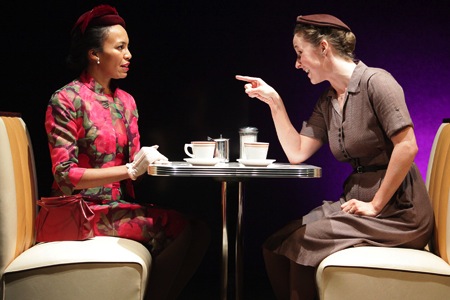Is a House a Home in the Segregated 1950s?
Luck of the Irish
Claire Tow Theater/Lincoln Center
150 West 65th Street
New York, N.Y.

In the middle of the nineteenth century, Boston was the capital of the anti-slavery movement. The capital of Massachusetts was the home of several well-known abolitionist newspapers; the state was led politically by anti-slavery champions such as Senator Charles Sumner and Governor John Andrew, and the 54th Massachusetts -- the first African American regiment in the Union Army -- was mustered near the city in 1863.
In the middle of the twentieth century, though, Boston was a hotbed of racism. The Boston Red Sox was one of the last teams to be integrated (Pumpsie Green in 1959) and housing in the Boston area was still segregated. The New England city had actually made enormous backward strides over the prior century.
This is the backdrop for Luck of the Irish, a powerful drama about how a white couple “fronted” for a black couple so they could buy a house in the fictional Boston suburb of Billington. It was a practice known as “ghost buying” and widely used all over the country at the time.
In Kirsten Greenidge’s play, which opened last week, upwardly mobile African American Dr. Rex Taylor and his wife move to Greater Boston in the mid-1950s, ignoring nearby Medford, which was integrated, and purchased a home in a lovely town full of green, tree-lined streets and houses owned by white families. A white couple, the Donovans, signed the mortgage papers for them. They settled in and led a reasonably good life. Now, sixty years later, descendants of the couple that “ghosted” for them claim that the original purchase agreement contained a technicality and now, after all this time, they want the house back. An uproar follows.
Luck of the Irish has a dreadfully slow first half hour filled with endless chatter about nothing. We learn that Dr. Taylor’s two grandchildren now own the house and are afraid they will lose a court battle to the Donovans. Talk, talk and more talk, all going nowhere.
As soon as the second act begins, the play soars. It is then that we learn the terrible secrets involved in the arrangement between the two couples back in the 1950s. The second act is full of deceit, chicanery, jealousy and greed, but it is full of hope, trust and triumph, too. The Donovans want that house, Mrs. Donovan wails near the end of the play, because working-class white people like them deserve more out of life than a middle-class black doctor.
Greenidge’s play shines a spotlight on racial housing problems of the 1950s, in the days before the civil rights crusades against discrimination in housing (the playwright’s own grandparents used “ghost buying” to get a home). The struggles of minorities to buy homes were mostly overlooked, rarely reported in newspapers and kept secret.
Playwright Greenidge does a fine job of outlining the racism in suburban America at that time. Mrs. Taylor, for instance, has to keep smiling at the tawdry “welcome wagon” food that her incensed white neighbors bring her, highlighted by frozen Sarah Lee pound cake. She also keeps track, daily, of the number of “for sale” signs that go up in the neighborhood when they arrive. Her husband, the doctor, has to work harder than the white doctors to prove himself. Mrs. Taylor has to continually downplay her background (she is well-educated and a world traveler). It is an angry and focused look at the resentment of some whites in suburbs in that wonderfully “innocent” decade of the 1950s.
The play, that takes place on a stage filled with sparse furniture, is nicely directed by Rebecca Taichman. She has the actors underplay just about everything and, in the end, the result is a low-key racial wallop to the stomach. The play has been compared to the very successful Clybourne Park, which tracked racial animosities in Chicago in that same time period. Luck of the Irish is powerful, but in a slow burning way. Clybourne Park was a racial tsunami.
Director Taichman gets wonderful performances from Carra Patterson and Marsha Stephanie Blake as Nessa Hannah, the 2013 sisters, Victor Williams and Elsa Davis as Rex and Lucy Taylor, Robert Hogan and Jenny O’Hara as the elder Joe Donovan and the elder Mrs. Donovan and Dashiell Eaves as the younger Joe Donovan and a superb Amanda Quaid as the younger Mrs. Donovan.
PRODUCTION: Sets: Mimi Lien, Costumes: Dana Botez; Lighting: Justin Townsend; Sound: Matt Tierney. The play is directed by Rebecca Taichman. Through March 10.
